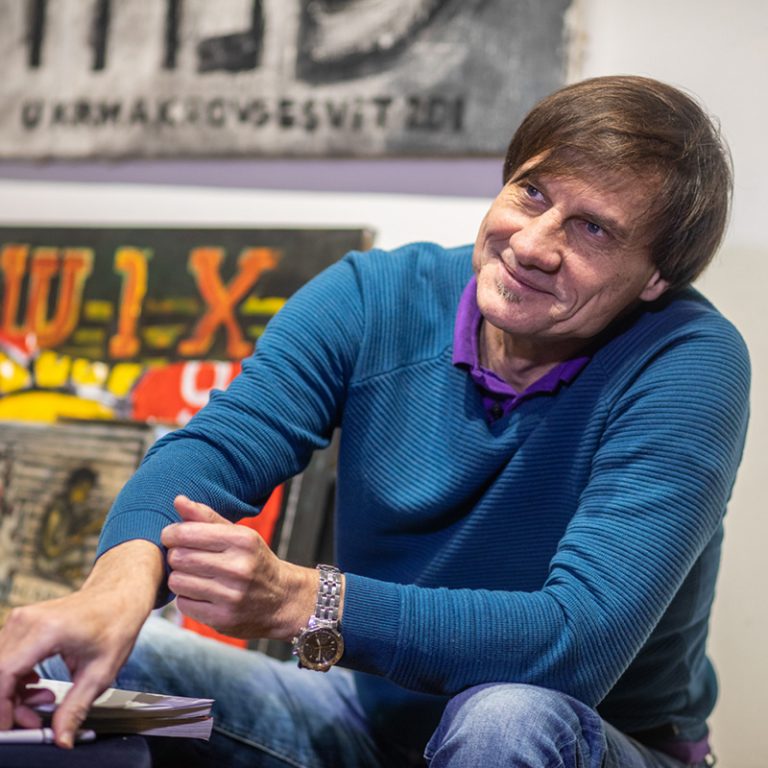From the very beginning of the war in the east of Ukraine, artist Serhii Zakharov protested against the seizure of Donetsk by Russian militants. Because of his art installations, the artist was detained in a basement of the terrorists from the territories of Eastern Ukraine temporarily occupied by the Russian Federation for six weeks, where he was interrogated and tortured. Today, Serhii lives in Kyiv and participates in rehabilitation projects for former prisoners, prisoners of war and soldiers.
Street art is considered an independent form of visual art, intrinsic to the urban environment. In its broadest sense, the term includes anything drawn or written on urban streets, public transport, or other such places. The earliest examples of the art form were observed on the walls of ancient cities. Street art as we know it today took shape in the twentieth century; its most common manifestation is graffiti, but the term also covers stencil art, poster art, murals, installations, and street performance art.
By creating independent street art, artists try to change the spaces around them: to make them more beautiful and appealing, to give buildings a deeper level of meaning, or to create a platform to present themselves and their works to the public. Street art is often used to try to express political views or opposition to the authorities.
One of the most impressive figures in street art culture is the British artist and political activist who goes by the name of Banksy, known for his works on thorny socio-political issues. The state often tries to destroy political art or appropriate it at the legislative level, thus depriving it of protest spirit. For example, Banksy’s 2017 Brexit-themed graffiti, painted on the wall of an abandoned building, was painted over in 2019.
The graffiti side of street art culture is also actively developing in Ukraine today. The art form is especially popular in big cities like Kyiv, Kharkiv, Odesa and Lviv. One of Ukraine’s best-known street artists is Hamlet Zinkovskyi from Kharkiv, whose works have been repeatedly painted over by the municipal cleaning services. However, it was in eastern Ukraine that street art took on a new role as a form of political resistance, after the occupation of Donetsk by Russian troops.

Serhii Zakharov. The art of ‘Murzylky’
Artist Serhii Zakharov had been living and working in Donetsk all his life. He has been drawing and painting since childhood; however, since he did not have the opportunity to earn a living as an artist, he went into interior design and furniture. However, in the heart of the city, Serhii recalls that there were always opportunities for art and artists to develop.
For the artist, along with the entire city, normal life ceased in 2014 with the beginning of the Russian-Ukrainian war and the occupation of part of eastern Ukraine by Russian troops. In the meantime, Ukrainians formed a protest movement against the new regime.
“For me, Ukraine began with Maidan (the Revolution of Dignity in 2013-2014 — ed.). Before that, I was the same as everyone else, the same product of the post-Soviet era. I demanded nothing more from life than a comfortable place.”
Serhii says that since the transition of power and the establishment of a new system, some of the locals have done everything to show that Donetsk is Ukraine.
“Stencils appeared with the tryzub (a trident, the Ukrainian state coat of arms — tr.). I lived in the city centre, where there was a slagheap, and someone planted a flag in it. Someone else tore it down. Next time you go out, you see the flag again. So, there was a kind of struggle, only the struggle was no longer happening at political rallies, it was more an exchange of symbols.”
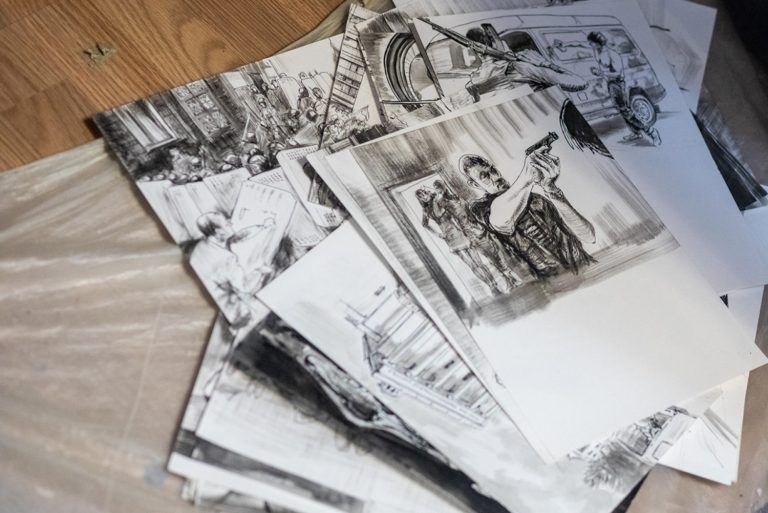
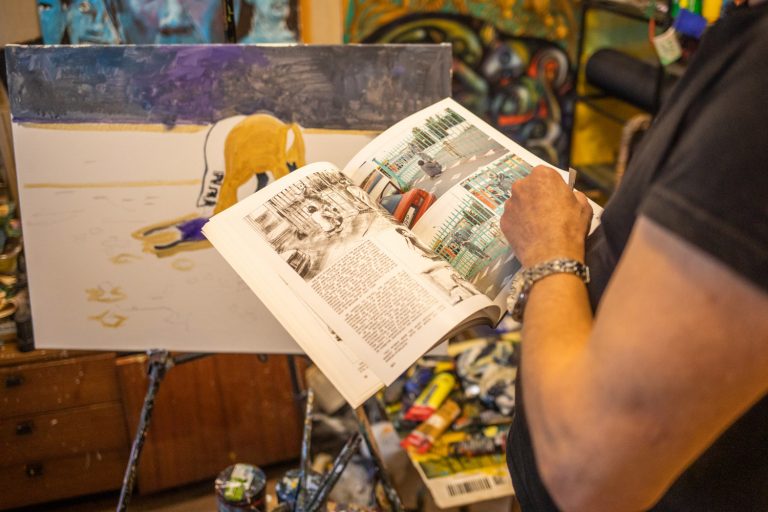
slideshow
When general resistance began among the Donetsk locals, Serhii had the idea of establishing an art group that would create political cartoons in the city streets. Even then, the artist understood that it was necessary to fight the occupation on a mental level in order to change the people’s mindset, to show them caricatures of the territories leaders. Street art was their chosen form of resistance because it allowed them to exhibit their works to a wide audience, as well as changing the space, architecture and visual picture of the occupied city. This is how the ‘Murzylky’ association was created (named after a fictional character in Soviet children’s literature — tr.), which included Serhii himself and a photographer friend. Other friends refused the artist’s invitation to join the group, out of fear for themselves and their loved ones.
“I imagined it would be a group, and suggested it to my friends, but they refused. I understand their reasons. But the person who stayed — he helped, and was almost the most valuable of all. Because he was a photographer, he had a camera, and everything was recorded on camera.”
Serhii says that the locals would actively express pro-Ukrainian views “until the first person was murdered in the city”. After the killings began, it became very dangerous to wear Ukrainian symbols or openly oppose the occupiers. A curfew was established in the city, making it impossible for the group to work at night. Appearing on the street at night could result in arrest.
The first artworks were created by the artist at home; in the morning, before the curfew ended, Serhii and the photographer went out into the city to put them up. Each drawing or installation was immediately photographed and then shared on social media, so that more people could see that in the city there was artistic resistance to the occupation. At first it was scary; then it became easier to install the artworks. Serhii and his partner were gaining experience and already knew what to do.
“Each installation was a special task, because we first needed to choose the place. You knew that if there were video surveillance cameras, there was no way. So you needed to put the car here, and put the work there. I mean, it was already such a guerrilla experience, working out how to do it.”
In this way, cardboard installations began to appear on the streets of Donetsk, located in places significant to the occupiers. One piece depicted Motorola, one of the separatist leaders, as the devil. It was placed near the registry office where his wedding took place. Opposite the ‘Velykobrytania’ (Great Britain — tr.) Hotel, where the militants lived, they painted Sharikov (a character from M. Bulgakov’s novel ‘Heart of a Dog’ — ed.). However, the separatists were most angered by the image of their leader, Igor Girkin (a war criminal; one of the terrorist leaders, also known by the pseudonym Igor Strielkov — ed.), with a pistol to his temple and the caption ‘Just do it’. This image incited the militants to hunt down the clandestine street artists.

The basement of terrorists
Serhii’s desire to resist the occupation was constantly accompanied by fear for his own life and the lives of his relatives and friends, as well as fear for the people around him. He was frightened by the risk of being caught and arrested while putting up one of his caricatures. At the same time, the artist could not even imagine that the militants would capture and torture him in revenge for his street art.
“I thought that no one would look for an artist who was just painting things. I thought nobody cared about that. I mean, even from my peacetime experience, when my car was vandalised: when you go to the police, they don’t look for anyone. And in this case, a guy just painted something. Who was going to come after an artist? I was wrong about that.”
Serhii believes he miscalculated the risks of posting his artworks on the internet and giving interviews to various media outlets. A journalist from the Russian TV channel ‘Dozhd’ once asked the artist for an interview. The next day, Serhii was found by militants and taken to the former premises of the Security Service of Ukraine (Ukr. acronym — SBU) in Donetsk.
“What was wrong? I called from my phone number. Then they found me using my phone signal. I can’t claim that he (the journalist from the TV channel ‘Dozhd’ — ed.) betrayed me. I mean, his phone was also tapped.”

After his detention and arrest ‘for propaganda activities’, Serhii was taken to the basement of the former SBU premises where he suffered beatings and broken ribs, and was subjected to mock executions and other forms of torture. In the cell, Serhii was handcuffed to another prisoner.
“I was lucky. In what way? Stas Asieiev (a journalist and blogger from Donetsk — ed.) has recently been released, and he was there for two years. I was there for six weeks.”
The first time he was freed from captivity was completely accidental. Serhii says the guards needed someone to paint the car in camouflage colours. In fact, he was released for this task; plus, he was given some clothes and 5 hryvnias (around 20 US cents — tr.) to travel home. However, he did not get his passport back: he was told to come back to the SBU premises to collect it. When he returned several days later to collect his documents, the artist was taken prisoner for a second time, because no one knew why he had been released.
He was finally released thanks to his girlfriend, who had worked in the State Penitentiary Service before the occupation. She had contacts among the separatists who were former officers of the Ukrainian police force (at that time still called the ‘militsia’, as in the Soviet era). Thanks to these contacts, she was able to get Serhii released.
“As always, it’s the ‘telephone law’: someone puts in a good word for someone. That’s it! There were no negotiations, no exchanges, nothing like that. That’s how it was at that time. If it had happened later, I think it would have been harder. Later, we would have had to use other processes, other mechanisms.”

The move and ‘Izolyatsia’
After being released for the second time, Serhii decided to leave the occupied territories, realising that one way or another, he would be under the close supervision of local authorities. Considering where to move, he opted for Kyiv, where he had a school friend who could help with accommodation and finding work. The artist had neither of these at the time of moving, and only 500 hryvnias (less than 20 US dollars — tr.) in his pocket.
“This is yet another difficult step for all forced migrants. It’s not only leaving the place where you lived, where everything is familiar. Where you had your identity, connections, a job, and so on, a source of funding. It’s like you’re just throwing that away and going into nowhere.”
At first he lived in the office of a classmate and was looking for a job. Word got around that the Donetsk artist Serhii Zakharov had moved to Kyiv; it reached the international charitable foundation ‘Izolyatsia’, which works on preserving the memory of Donbas as well as the question of its reintegration into Ukraine.

Together with ‘Izolyatsia’, Serhii created the ‘House of Cards’ project, to convey to viewers the instability of the occupying regime in Donbas, and its dependence on the support of the Russian authorities. As part of this project, the artist visited Germany and the Czech Republic.
“At that time it was important. Now I can look at it with a bit of distance. There was an installation called ‘House of Cards’, with big playing cards depicting all these militants. The main idea is that if we build this house of cards, there’s a joker card with a picture of Putin on it. If we knock out this card, the whole house — in other words, the territories of Eastern Ukraine temporarily occupied by the Russian Federation — will just collapse, and that’ll be the end of it.”
Several more projects were implemented together with the foundation, aimed at debunking the myths surrounding Donbas, and depicting the part played by Russia and Russians in the occupation of Ukrainian territories. In particular, the graphic novel ‘Hole’ was created, the first drafts of which were made by Serhii back in Donetsk. The comic is based on real events in the occupied city, the beginning of the ‘Russian Spring’ in eastern Ukraine.
‘Russian Spring’
The period of protests in the east of Ukraine in March-April 2014, organised by Russian special forces and mercenaries in order to destabilise the situation in Ukraine.“Back when I was in Donetsk, I thought I would draw what I saw there. But I drew only one picture there, because my relatives would hit me on the hands and tell me “Don’t do this!”.
The graphic novel, and all of Serhii’s works related to the occupation and his captivity and torture in the basement of terrorists, are important primarily for their visual aspect. Former prisoners usually talk about their captivity — for example, Stanislav Asieiev, in his book ‘Path of Light: The Story of a Concentration Camp’ — but few are able to show how it all happened, enabling people to see the torture and humiliation with their own eyes.
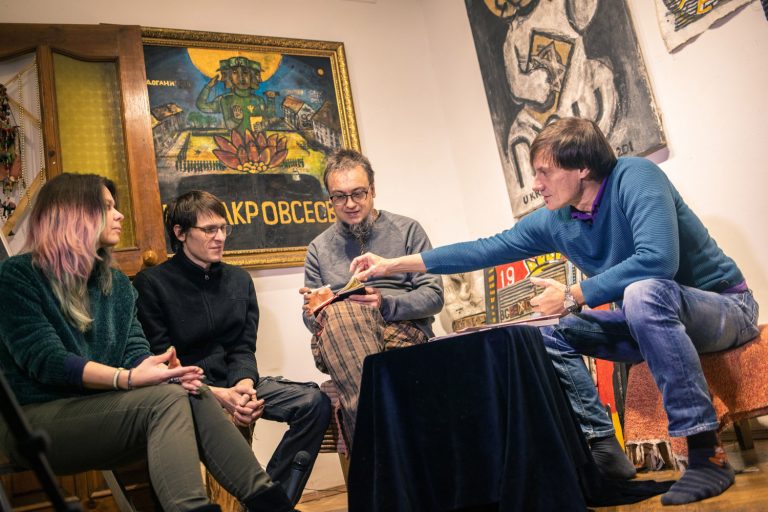
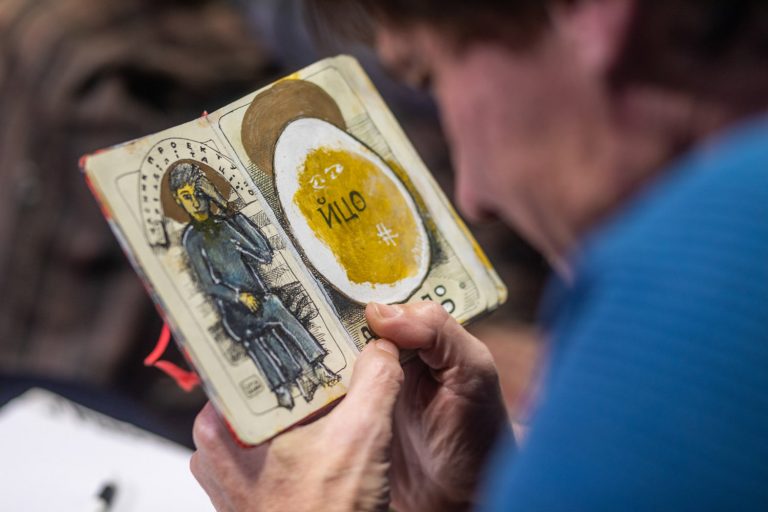
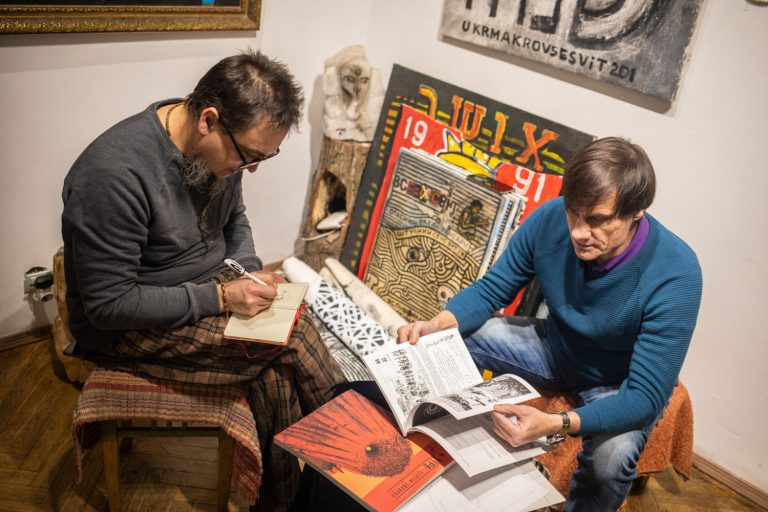
slideshow
Rehabilitation through Art
Serhii is currently involved in a rehabilitation project for combatants in the East, former captives and prisoners. The event, organised by the Art Initiative of Temporary Unification of Values (Ukr. acronym — MITEC) in cooperation with the Lviv Psychoanalytic Institute of Mental Health, started in November 2020. Masterclasses of the ‘MITEC. Rehabilitation Space’ project will be attended by veterans, psychologists and artists, allowing each ATO/JFO veteran or former prisoner to undergo a kind of art therapy and open up through creativity.
ATO (anti-terrorist operation) and JFO (joint forces operation)
A set of measures aimed at counteracting the activities of illegal Russian and pro-Russian organisations in the war in eastern Ukraine. In April 2018, the ATO became the JFO (Joint Forces Operation) with the transfer of control from the SBU to the Joint Operational Headquarters of the Armed Forces of Ukraine.In many ways, art is also a form of therapy for Serhii himself, his method of communicating with the world, conveying his experiences and feelings, and talking about things that sometimes cannot be expressed in words. He, like many other forced migrants, wants Donetsk to return to Ukraine, and he wants to go back to a Ukrainian Donetsk.
“It is clear that all parts in other areas also have to pass, these values for which people came out to Maidan. In other words, we don’t need to return there — to the Russian world — but to move towards a normal European society, towards a normal country.”
supported by
Material prepared with support of United States Agency for International Development (USAID)


